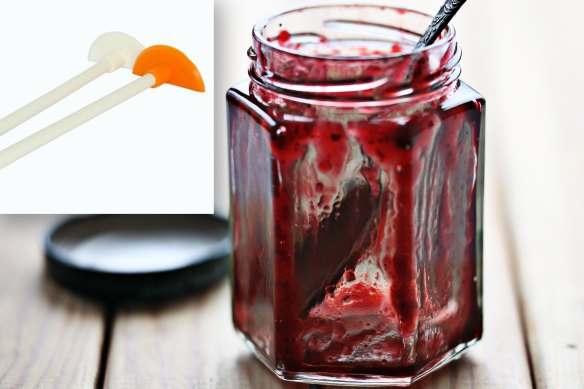Opinion
The $3 Dutch household item every person needs in the cost-of-living crisis
Sarah Brookes
JournalistThe rising cost of living has many scraping together savings any way they can, with Finder data released on Wednesday reporting nearly half of West Australians are struggling to pay their home loan.
On top of that 42 per cent, one in 10 missed a mortgage payment in the past two years – 6 per cent missed just one payment, another 6 per cent missed more.

Stuck with plenty of jam, but no way to get it out? Enter the flessenlikker - quite literally “bottle licker”.Credit: Getty Images/Supplied
Home loan expert Richard Whitten said many mortgage holders were in survival mode, skipping everything from meals to mobile bills to stay on top of repayments.
“The average person living in WA has $29,861 in cash savings, however the big savers are pulling up the average, with 41 per cent having less than $1000 in their savings account,” he said.
Enter the flessenlikker (translation: bottle licker), which I was introduced to when I lived in the countryside on the border of the Netherlands and Germany back in 2010.
How I ended up living in half of a rambling homestead on a dairy farm next door to a quasi-famous Dutch soap actor is a story for another day.
Today we’re talking about a flexible kitchen aid, like a mini silicon spatula, used to skilfully scrape the last cents’ worth of jam or Vegemite out of the jar; those last swipes you can never quite reach with a knife.
This quintessentially Dutch tool, which exemplifies the thriftiness of the people, was patented by a family-owned company in 1967.
Though some sources claim the flessenlikker is actually a Norwegian invention, the Netherlands is the only country I know of that considers this utensil a household essential.
I was so impressed with its simple ingenuity I brought handfuls back to Perth as Christmas presents to baffle the family, who guessed its potential uses: from removing dog poo from your shoes to a feminine hygiene device.
According to UnDutchables author Colin White, the Dutch are the thriftiest (or cheapest, depending on how you look at it) people in Europe.
Don’t be surprised if these penny-pinchers ask you for a contribution for the coffee if you’re invited to a circle party, a gathering that involves sitting in a circle all afternoon chatting while drinking tea and eating cake. It’s less of a party and more of a Sunday afternoon tea with Grandma vibe.
It’s not the only oddity in this tiny, flat dollhouse kingdom.
People are so skilled at cycling they can hold a brolly and a bunch of flowers while they do it and are so confident they scorn wearing helmets.
They consider it incredibly rude to forget somebody’s birthday, so they hang perpetual birthday calendars in their toilets.

The arrival of Sinterklaas and his helpers Black Pete in Monnickendam, Netherlands.Credit: Patrick Post
And while here in Australia fairy bread is reserved for kids’ birthday parties, there it’s a breakfast staple and Dutch supermarket breakfast aisles contain not cereal but the most ludicrous selection of hundreds and thousands to sprinkle on buttered bread to make hagelslag (hail storm).
Not weird enough for you? Dutch Santa, known as Sinterklaas, doesn’t live in the North Pole but in Spain, and each November he makes his way by steam boat to the Netherlands. That’s fine, but his servant sidekick – the blackface character known as Zwarte Piet or “Black Pete” – is deeply offensive to many.
Not one of the traditions I was keen to bring home.
But when my teenage daughter wrote on the shopping list, “URGENT NEED NUTELLA!!!!!”, which frankly is debatable when budget cuts are in full swing in the Brookes household, I whipped out the nifty jar licker and scraped out enough for two sandwiches.
A simple hack to beat the war on shrinkflation and negate a visit to IGA where I know a quick trip to buy milk, bread, eggs, and that hazelnut spread will cost $50.
CEDA research shows Australians are living through the most protracted period of economic misery since 2011; economist Liam Dillon said the “misery index” remained high since COVID-19 and was starting to rise again.
“Most forecasts anticipate the worst-behaved element of the index recently (inflation) will continue to ease over the coming year,” he said.
“As it does, the RBA will have increased scope to lower interest rates. With both measures falling, misery too should ease.”
Until then, the bottle licker remains a must-have household item in my book.
Start the day with a summary of the day’s most important and interesting stories, analysis and insights. Sign up for our Morning Edition newsletter.